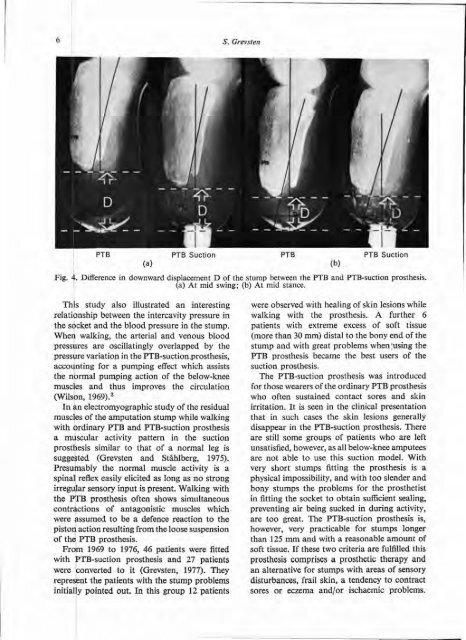Prosthetics and Orthotics
Prosthetics and Orthotics
Prosthetics and Orthotics
You also want an ePaper? Increase the reach of your titles
YUMPU automatically turns print PDFs into web optimized ePapers that Google loves.
Fig. 4. Difference in downward displacement D of the stump between the PTB <strong>and</strong> PTB-suction prosthesis.<br />
(a) At mid swing; (b) At mid stance.<br />
This study also illustrated an interesting<br />
relationship between the intercavity pressure in<br />
the socket <strong>and</strong> the blood pressure in the stump.<br />
When walking, the arterial <strong>and</strong> venous blood<br />
pressures are oscillatingly overlapped by the<br />
pressure variation in the PTB-suction prosthesis,<br />
accounting for a pumping effect which assists<br />
the normal pumping action of the below-knee<br />
muscles <strong>and</strong> thus improves the circulation<br />
(Wilson, 1969). 2<br />
In AN electromyographic study of the residual<br />
muscles of the amputation stump while walking<br />
with ordinary PTB <strong>and</strong> PTB-suction prosthesis<br />
a muscular activity pattern in the suction<br />
prosthesis similar to that of a normal leg is<br />
suggested (Grevsten <strong>and</strong> Ståhlberg, 1975).<br />
Presumably the normal muscle activity is a<br />
spinal reflex easily elicited as long as no strong<br />
irregular sensory input is present. Walking with<br />
the PTB prosthesis often shows simultaneous<br />
contractions of antagonistic muscles which<br />
were assumed to be a defence reaction to the<br />
piston action resulting from the loose suspension<br />
of the PTB prosthesis.<br />
From 1969 to 1976, 46 patients were fitted<br />
with PTB-suction prosthesis <strong>and</strong> 27 patients<br />
were converted to it (Grevsten, 1977). They<br />
represent the patients with the stump problems<br />
initially pointed out. In this group 12 patients<br />
were observed with healing of skin lesions while<br />
walking with the prosthesis. A further 6<br />
patients with extreme excess of soft tissue<br />
(more than 30 mm) distal to the bony end of the<br />
stump <strong>and</strong> with great problems when using the<br />
PTB prosthesis became the best users of the<br />
suction prosthesis.<br />
The PTB-suction prosthesis was introduced<br />
for those wearers of the ordinary PTB prosthesis<br />
who often sustained contact sores <strong>and</strong> skin<br />
irritation. It is seen in the clinical presentation<br />
that in such cases the skin lesions generally<br />
disappear in the PTB-suction prosthesis. There<br />
are still some groups of patients who are left<br />
unsatisfied, however, as all below-knee amputees<br />
are not able to use this suction model. With<br />
very short stumps fitting the prosthesis is a<br />
physical impossibility, <strong>and</strong> with too slender <strong>and</strong><br />
bony stumps the problems for the prosthetist<br />
in fitting the socket to obtain sufficient sealing,<br />
preventing air being sucked in during activity,<br />
are too great. The PTB-suction prosthesis is,<br />
however, very practicable for stumps longer<br />
than 125 mm <strong>and</strong> with a reasonable amount of<br />
soft tissue. If these two criteria are fulfilled this<br />
prosthesis comprises a prosthetic therapy <strong>and</strong><br />
an alternative for stumps with areas of sensory<br />
disturbances, frail skin, a tendency to contract<br />
sores or eczema <strong>and</strong>/or ischaemic problems.

















